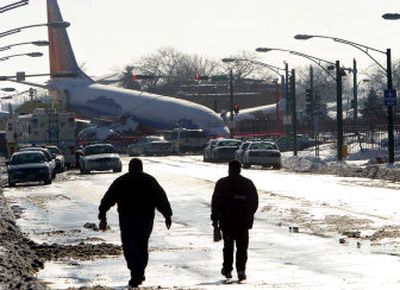Short runway, bad weather suspected factors in jet crash

DALLAS – Investigators looking into the accident that resulted in Southwest Airlines Co.’s first crash fatality appeared to be focused initially on a blustering snowstorm as a potential factor.
The relatively short runways at Chicago Midway Airport also likely played a role in the incident, in which a Boeing 737-700 smashed through a blast fence Thursday and skidded onto a busy street, killing a 6-year-old boy.
Officials for the National Transportation Safety Board cautioned Friday that it’s far too soon to determine an official cause for the accident, the second incident of its kind in recent years for the Dallas-based carrier.
“It is a sad day for Southwest, and we are going to focus all of our efforts on taking care of our passengers and their families and supporting the NTSB investigation,” airline chief executive Gary Kelly said during a news conference at company headquarters in Dallas.
As discount carriers like Southwest look to hold down costs by using secondary airports such as Chicago Midway, pilots are increasingly finding themselves in tight quarters when they’re landing big jets.
The shorter runways at many older airports leave less room for either error or bad luck with the weather.
“The more you have businesses and public areas encroaching, the less space you have for airplanes to run off before they hit something,” said Hans Weber, president of aviation technology management consulting company Pecop International Inc.
Thirteen people were injured in the accident. Most of those injured were in vehicles at the intersection adjacent to the city airport.
On March 5, 2000, a Southwest 737 overran a runway at Burbank Airport in Southern California, crashing through the blast fence and stopping within feet of a gasoline station. All 142 passengers and crewmembers survived that accident, although several dozen were treated for injuries.
Part of the problem is many runways at U.S. commercial airports don’t have the 1,000-foot safety margins recommended by the Federal Aviation Administration – including some at Midway and Dallas’ Love Field.
FAA spokeswoman Laura Brown says the shorter runways are still considered safe.
But that smaller safety margin becomes more apparent during bad weather, such as the storm that left nearly 8 inches of snow on Chicago on Thursday.
“It’s a problem for older airports that never had a lot of space to begin with. They’re hemmed in. It’s riskier,” said Weber.
Pilots consider the Midway runway relatively short at 6,500 feet, compared with 8,800 at Love Field.
“It is certainly an adequate runway,” Kelly said. “We’ve operated at Midway for 20 years without incident.”
Early speculation on the cause of the accident centered on the runway’s length since the airplane barreled into traffic. Some safety experts say they also are interested in where the pilot touched down on the runway.
“You can probably rule out any mechanical problem,” said Jeff Morof, a Chicago aviation attorney.
Southwest couldn’t immediately say where on the runway the plane touched down.
Aviation lawyer Daniel O. Rose said the crashes might be indicative of a “carrierwide operational problem.”
Rose said Southwest had decided to disconnect its automatic braking system as a “cost-saving method.”
The Boeing 737-700 that crashed at Midway was equipped with automatic braking and anti-skid systems. Southwest confirmed it doesn’t use the systems.
“We do not deploy automatic braking at this point at Southwest Airlines,” said Kelly. “We let our flight crews make the determination to brake the aircraft. That is a procedural choice available to each airline.”
The Boeing 737 is FAA-certified to operate with or without the automatic braking system in use, Boeing spokeswoman Sandra Angers told Bloomberg News. Because it is an airline decision, Boeing has no data on how often it is used, she said.